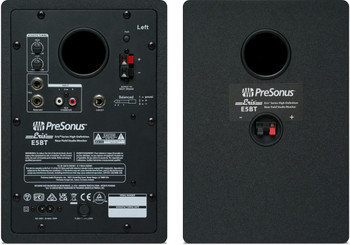Description
Eris, Remastered.
Eris E8 XT: 2-Way Active Studio Monitors with Wave Guide
Our best-selling studio monitors just got better.
With their smooth, accurate frequency response; powerful amplification with tons of headroom; and acoustic tuning functions that ensure you always get the best sound, it's no wonder that Eris®-series studio monitors have been a runaway hit since their introduction. The Eris E8 XT is a substantial update to a lauded classic. Deeper lows and a wider, more controlled sweet spot (thanks to its new EBM waveguide) mean that our best-selling studio monitors just got even better.
Features
- Components and construction
- 8-inch woven composite low-frequency transducer
- 1.25-inch (31.75 mm), ultra-low-mass, silk-dome, high-frequency transducer
- Front-firing acoustic port for superior bass-frequency reproduction
- Optimized, resonance-suppressing internal bracing
- 105 dB maximum continuous SPL
- User controls
- HF Adjust (±6 dB, continuously variable)
- Midrange Adjust (±6 dB, continuously variable)
- Acoustic Space settings (flat, -2, -4 dB) for accurate mixing contour
- Highpass filter (Off, 80 Hz, 100 Hz)
- Power and safety
- 130 watt, Class AB biamplification
- RF interference, output current limiting, over-temperature, transient, and subsonic protection
- Amplifier “soft start” feature eliminates popping on power-up
- Internal power supply with IEC connector
- Power switch with on/off LED
- Inputs and outputs
- Balanced XLR/¼-inch
- Unbalanced RCA inputs (E5/E8)
Studio speakers with a wide sweet spot.
We outfitted Eris XT studio monitors with a new EBM (Elliptical Boundary Modeled) waveguide designed by none other than Hugh Sarvis of WorxAudio, the mind behind our award-winning CDL loudspeakers and lauded R-series monitors. The result? A superior high-frequency response and wider 100-degree horizontal dispersion to create a broader sweet spot—ideal for group listening and collaboration. Narrow vertical dispersion reduces reflections from your desk. Silk-dome tweeters ensure snappy, accurate transient reproduction.
Lows that go lower.
The familiar woven composite low-frequency driver offers Eris' signature tight, clear bass, plenty of punch, and no flab. Eris E8 XT studio monitors sport a ported enclosure that is larger than that of their predecessors, allowing them to reach down to an astonishing 35 Hz. That's 10 Hz below previous models—with no subwoofer!
Set up your studio monitors for your room.
Modern recording studios can be anywhere from a spare bedroom to a multi-million dollar facility. That's why every studio monitor we make is equipped with controls that ensure the flattest response in your mix environment. Acoustic tuning controls allow you to configure the Eris E8 XT perfectly for your room: You get Low-cut, Mid, and High controls, as well as 3-way Acoustic Space tuning that allows you to easily compensate for the sonic consequences of speaker placement against a wall or in a corner.
Studio monitor connections.
It’s easy to feed audio to your Eris E8 XT studio monitors from an audio interface, mixer, monitor controller, or almost any other line-level source. Eris E8 XT monitors provide balanced XLR, balanced ¼-inch TRS, and unbalanced RCA line-level inputs. You’ll have no problem hooking your Eris speakers up to virtually anything.
Accuracy defined.
Suitable for both home recording studios and professional mix engineering, the Eris XT studio monitors combine sterling audio quality with the flexible tuning and connectivity you've come to expect from PreSonus®. It’s Eris remastered.
Ala Kazam!
Did you know? PreSonus studio monitors and media reference monitors include a special edition of Studio Magic, a suite of over $1000 USD worth of music software including Studio One Prime and more plug-ins, loops, virtual instruments, effects, and tutorials than you may ever need. The Magic edition of Studio One Prime is compatible with all of the included plug-ins, of course, and because they're included in VST, AU, and AAX formats, you can also use them in any DAW you’d like.
It doesn't matter if you’re working on your first podcast episode or your tenth Grammy—you'll find yourself conjuring from the book of Studio Magic sooner than later. Have fun!
Specifications
Technical Specifications
Inputs
- 1- Balanced XLR
- 1- Balanced ¼” TRS
- 1- Unbalanced RCA
Performance
- Frequency Response 35 Hz - 20 kHz
- Crossover Frequency 2.2 kHz
- LF Amplifier Power 75W
- HF Amplifier Power 65W
- Peak SPL (@ 1 meter) 105 dB
- LF Driver 8” reinforced woofer
- HF Driver 1.25” silk dome tweeter
- Input Impedance 10 kΩ
- Dispersion 100 degrees horizontal by 60 degrees vertical
User Controls
- Volume Range A-type taper
- MF Control -6, 0, +6 dB
- HF Control -6, 0, +6 dB
- Low Cut Flat, 80 Hz, 100 Hz
- Acoustic Space Flat, -2 dB, -4 dB
Protection
- RF interference
- Output-current limiting
- Over-temperature
- Turn-on/off transient
- Subsonic filter
- External mains fuse
Power
- 100-120V ~50/60 Hz or 220-240V ~50/60 Hz
Cabinet
- Vinyl-laminated, medium-density fiberboard
Physical
- Width 9.75” (247.65 mm)
- Depth 11.5” (292.1 mm)
- Height 16” (406.4 mm)
- Weight 23 lbs (10.43 kg)





















